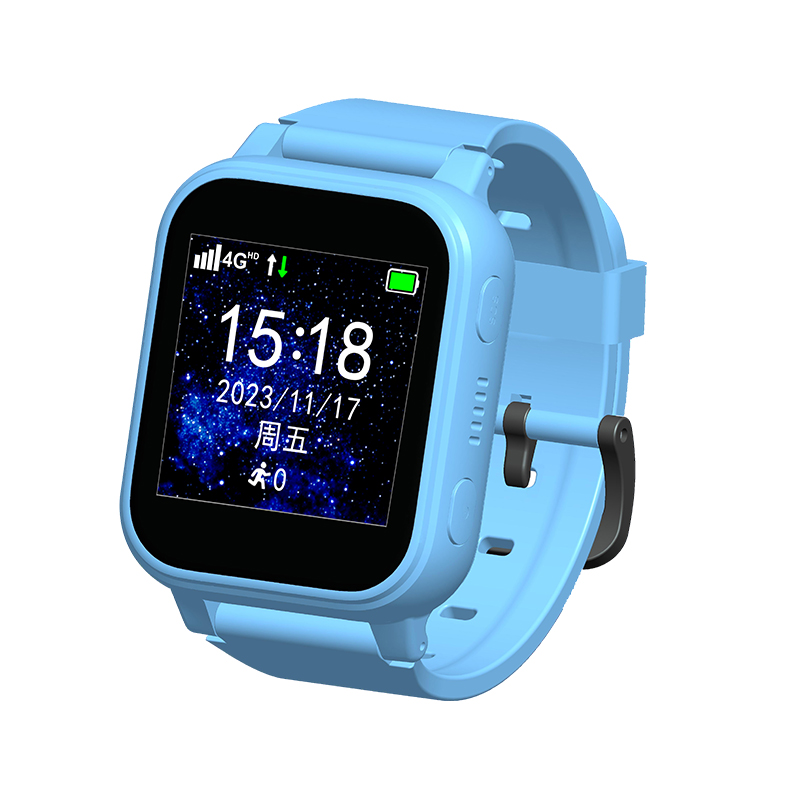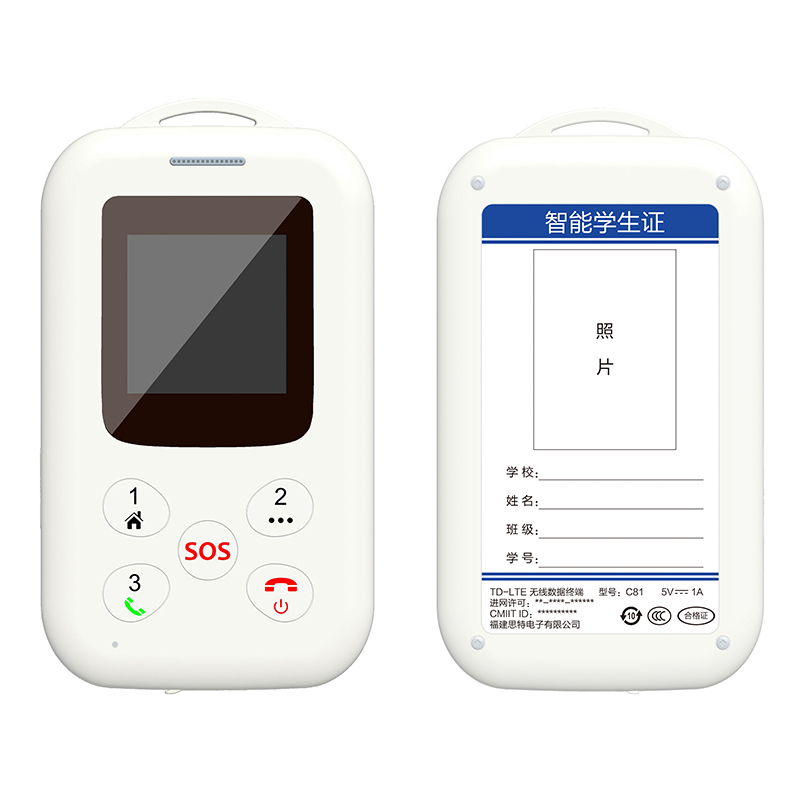How does the kids' cell phone simplify the campus card system and enhance identity authentication security?
Release Time : 2025-11-11
With the deepening of smart campus construction, traditional campus card systems are facing problems such as fragmented functions, inconvenience in carrying, and susceptibility to loss and misuse. The smart kids' cell phone, integrating NFC, 2.4G contactless communication, and trusted student identity authentication technologies, is becoming a new generation of campus identity carrier. It not only integrates multiple scenarios such as access control, attendance, consumption, and library borrowing onto the wrist, but also enhances the reliability of identity authentication through multiple security mechanisms, truly achieving "one-form access, secure and reliable," bringing a revolutionary upgrade to campus management and student safety.
1. Multifunctional Integration, Reconstructing the Campus Card Experience
Traditional campus cards require students to carry physical cards, which are easily lost, damaged, or forgotten, especially among young children. The kids' cell phone embeds an NFC chip into the device itself, naturally possessing the attribute of "person and card in one"—students wear the card and hold it. Through pre-authorization binding, the watch can seamlessly replace the original campus card, enabling applications across all scenarios such as cafeteria payments, library borrowing, dormitory access control, and sports venue access. Simultaneously, combined with 2.4G contactless attendance technology, students no longer need to actively swipe their cards when entering or leaving school gates or classrooms; the system automatically identifies and records location and time, significantly improving passage efficiency and reducing queuing congestion, especially suitable for peak hours.
2. "Trusted Student Identity" Strengthens the Foundation of Security Authentication
The "Trusted Student Identity" system introduced in the kids' cell phone is its core advantage, distinguishing it from ordinary smart wearable devices. This system is based on digital identity credentials uniformly issued by education authorities or schools, written into the watch's security chip through encryption algorithms to ensure that identity information is tamper-proof and unforgeable. Each time access control verification or payment is performed, the system not only reads the ID number but also performs two-way identity verification to prevent card duplication or emulation attacks. Some high-end models even support dynamic tokens or biometric-assisted authentication, further strengthening identity uniqueness and eliminating the risk of impersonation at the source.
3. Data Integration for Precise Campus Management
The kids' cell phone is not only an identity carrier but also a data entry point. Its integrated smart positioning, electronic fence, and SOS emergency call functions are deeply integrated with the campus card system. For example, when a student enters a laboratory or playground electronic fence area, the system can automatically trigger permission verification; if the watch detects abnormal stillness or an SOS signal, security personnel can immediately retrieve the student's recent card-swiping records and real-time location for a rapid response. Furthermore, parents can view their child's attendance, spending details, and activity trajectory through the parent-school interaction platform, achieving transparent co-management while protecting privacy, and building a secure closed loop of collaboration between family, school, and student.
4. A Design Philosophy Emphasizing Both Convenience and Security
In terms of user experience, the kids' cell phone abandons complex operations, adopting one-click calling, voice prompts, and color screen guidance, adapting to the cognitive level of primary school students. Its short NFC read/write distance and low power consumption allow transactions to be completed simply by bringing the phone close to the reader, avoiding accidental swiping. All communication data is encrypted using national cryptographic algorithms or AES during transmission. Local storage employs an independent secure zone (SE) to isolate sensitive information, ensuring that even if the device is lost, others cannot extract identity data. This "seamless access + high-security protection" design allows young users to enjoy convenient services while remaining under robust security.
The kids' cell phone, by integrating NFC, 2.4G communication, trusted identity authentication, and intelligent sensing technologies, not only simplifies the physical form and usage process of traditional campus cards but also significantly enhances the security level of campus identity authentication with "human-machine binding, dynamic verification, and data closed-loop" as its core. It serves as both a terminal touchpoint for smart campuses and a guardian of student safety.
1. Multifunctional Integration, Reconstructing the Campus Card Experience
Traditional campus cards require students to carry physical cards, which are easily lost, damaged, or forgotten, especially among young children. The kids' cell phone embeds an NFC chip into the device itself, naturally possessing the attribute of "person and card in one"—students wear the card and hold it. Through pre-authorization binding, the watch can seamlessly replace the original campus card, enabling applications across all scenarios such as cafeteria payments, library borrowing, dormitory access control, and sports venue access. Simultaneously, combined with 2.4G contactless attendance technology, students no longer need to actively swipe their cards when entering or leaving school gates or classrooms; the system automatically identifies and records location and time, significantly improving passage efficiency and reducing queuing congestion, especially suitable for peak hours.
2. "Trusted Student Identity" Strengthens the Foundation of Security Authentication
The "Trusted Student Identity" system introduced in the kids' cell phone is its core advantage, distinguishing it from ordinary smart wearable devices. This system is based on digital identity credentials uniformly issued by education authorities or schools, written into the watch's security chip through encryption algorithms to ensure that identity information is tamper-proof and unforgeable. Each time access control verification or payment is performed, the system not only reads the ID number but also performs two-way identity verification to prevent card duplication or emulation attacks. Some high-end models even support dynamic tokens or biometric-assisted authentication, further strengthening identity uniqueness and eliminating the risk of impersonation at the source.
3. Data Integration for Precise Campus Management
The kids' cell phone is not only an identity carrier but also a data entry point. Its integrated smart positioning, electronic fence, and SOS emergency call functions are deeply integrated with the campus card system. For example, when a student enters a laboratory or playground electronic fence area, the system can automatically trigger permission verification; if the watch detects abnormal stillness or an SOS signal, security personnel can immediately retrieve the student's recent card-swiping records and real-time location for a rapid response. Furthermore, parents can view their child's attendance, spending details, and activity trajectory through the parent-school interaction platform, achieving transparent co-management while protecting privacy, and building a secure closed loop of collaboration between family, school, and student.
4. A Design Philosophy Emphasizing Both Convenience and Security
In terms of user experience, the kids' cell phone abandons complex operations, adopting one-click calling, voice prompts, and color screen guidance, adapting to the cognitive level of primary school students. Its short NFC read/write distance and low power consumption allow transactions to be completed simply by bringing the phone close to the reader, avoiding accidental swiping. All communication data is encrypted using national cryptographic algorithms or AES during transmission. Local storage employs an independent secure zone (SE) to isolate sensitive information, ensuring that even if the device is lost, others cannot extract identity data. This "seamless access + high-security protection" design allows young users to enjoy convenient services while remaining under robust security.
The kids' cell phone, by integrating NFC, 2.4G communication, trusted identity authentication, and intelligent sensing technologies, not only simplifies the physical form and usage process of traditional campus cards but also significantly enhances the security level of campus identity authentication with "human-machine binding, dynamic verification, and data closed-loop" as its core. It serves as both a terminal touchpoint for smart campuses and a guardian of student safety.







